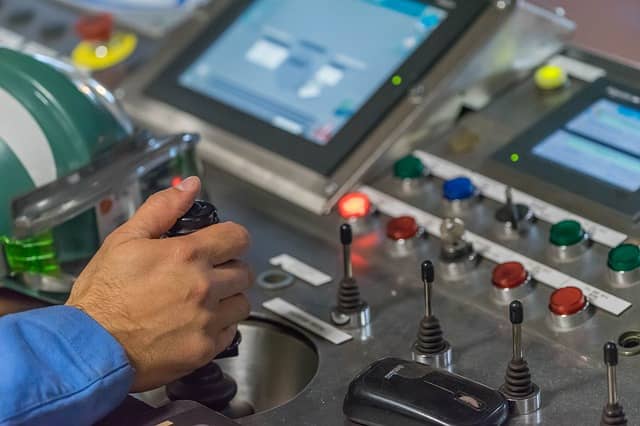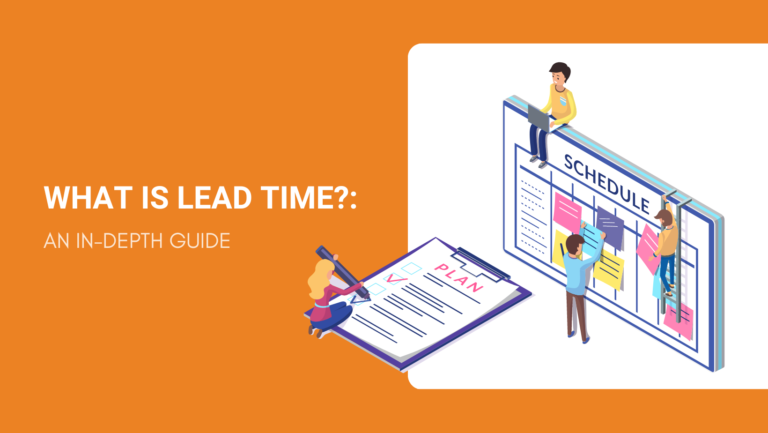Timing is everything in business. It is the beat that keeps supply chains running smoothly and profits flowing in as they should. It is thus no wonder that most suppliers use their lead times to market themselves as the perfect business partner.
But, what is lead time? Is it limited to manufacturing or does it encompass other aspects of the supply chain? More importantly, how does it impact your business?
If such questions have been keeping you up at night, you have found the right blog. Come along as we define lead time, explore the different types, and also share tips on managing your lead times to keep your business running smoothly.
Shall we begin?

What Is Lead Time?
Lead time is the duration between the start and the end of a process. It is a term reflecting aspects of business such as product sourcing, manufacturing, supply chain logistics, and much more.
Practical Examples of Lead Time
Take, for illustration, that you would like to start selling sunglasses in your online store. Naturally, the first step would be to decide what type of sunglasses you would like to offer and then find a manufacturer that can supply the sunglasses you require.
After finding a supplier and placing an order, you may encounter lead times in the following ways:
- If the supplier has the sunglasses in stock, the lead time will be the duration that they require to get them from storage, prepare, and pack them for shipping.
- If the supplier does not have any sunglasses in stock, then the lead time will be the number of days they need to manufacture the sunglasses, perform quality control, and pack them for shipping.
- Alternatively, if you require sunglasses branded with your logo, the lead time will include the duration it takes to customize the sunglasses, perform quality control, and pack them for shipping.
Types of Lead Times
The supply chain of every product comprises a series of steps. They start right from the sourcing of raw materials up until the sale of the finished product.
Subsequently, different types of lead times account for each of these processes. Let’s explore them in more detail, shall we?
Lead Time in Procurement

Lead time in procurement refers to the time it takes to complete the processes involved in buying goods. The processes include:
- Identifying the product you would like to buy
- Looking for suppliers (by yourself or through a sourcing company)
- Negotiating with suppliers
- Requesting, evaluating, and approving samples
- Placing an order
- Paying for your order
In most cases, you may only have to endure procurement lead times when sourcing a product for the first time from a new supplier. Subsequent orders are often less complicated because the supplier will only be replenishing your inventory.
Lead Time in Manufacturing

Lead times in manufacturing can vary based on the specifics of the project.
If you place an order with a manufacturer and they have the required raw materials, it means that they can go straight into production. The manufacturing lead time here will, therefore, be confined to how long it takes the manufacturer to:
- Produce the products you require
- Complete quality control processes
- Pack your products
On the other hand, if the manufacturer does not have the raw materials in stock, the manufacturing lead time may be longer. This is because they would first have to source the raw materials and prepare them before beginning actual production.
In light of this, it is advisable to consider the type of manufacturing project you are taking on and set aside ample time for it to avoid inconveniences.
Lead Time in Marketing

Lead time in marketing refers to the duration it takes to execute a marketing campaign. It usually includes time for:
- Research to understand your target market and the type of campaigns that would attract them
- Preparing ads and content for the campaign
- Posting the ads
- Sustaining regular engagement with your audience to create hype around the product you are marketing
- Holding launches, sales, or other promo events
Lead Time in Shipping

Shipping lead times begin when goods are dispatched from the supplier’s premises and end when they arrive at the buyer’s premises.
This type of lead time is often brief and more direct in local purchases because the delivery distance is shorter and the goods hardly ever require any clearances before transport.
In contrast, if you ship goods from China or other destinations beyond your borders, your shipping lead time would include time for processes such as:
- Transport from the supplier’s warehouse to the port
- Export clearances at the port
- Loading of the goods onto the transport vessel
- Freight
- Delivery at your local port
- Offloading
- Import clearances
- Last-mile delivery to your premises
Lead Time in Supply Chain

As its name suggests, a supply chain consists of a series of participants. In a typical supply chain the participants would include:
- A manufacturer
- A wholesaler/retailer
- A consumer
Lead time in a supply chain is, therefore, defined as the period it takes for products to move from the manufacturer to the retailer/wholesaler and finally to the end consumer. It can be measured cumulatively or in parts.
For example, if you (a retailer/wholesaler) order wholesale kitchen knives from a manufacturer, your supply chain lead time will be the duration between when the manufacturer accepts your order and when you receive it.
In comparison, the consumer’s supply chain lead time will be the time between when they place the order with your store and when they receive it.
Lead Time in Inventory Management

Take, for instance, that you sell hoodies. If you notice that your stock is running low and you intend to keep selling them, you will likely place a new order for more hoodies.
The lead time in inventory management is the period between the day you place the order to replenish your stock and the day you receive your fresh consignment of hoodies.
How to Calculate Lead Time

As illustrated by the definitions above, each type of lead time includes multiple tasks/processes. So, calculating lead time simply entails:
- Finding out how long each process will take
- Adding up the duration of each process to get the total lead time in a specific scenario
Take, for example, that you would like to calculate your lead time for inventory management. You would need to find out how long it takes
- For the manufacturer to receive and confirm your order
- To process your order i.e. produce, inspect, and pack your goods
- To transport the goods from the manufacturer to your premises
You would then sum up each of these timelines to find your inventory management lead time. To put it briefly:
Inventory management lead time = Total Order Processing Time + Total Shipping Time
This is only one example, but the general formula of adding up the timings of different tasks is applicable when calculating all types of lead times.
Factors That Affect Lead Time
Lead times vary depending on the supplier or the retailer. They can also vary from one order cycle to the next. Here are some of the key factors that contribute to such differences.
The Manufacturer’s Systems

Every factory has unique operation and production systems. Operation systems address factors such as:
- How the factory communicates with clients
- The kind of services they offer
- How the factory receives and handles orders from clients
- Pricing and MOQ
Production systems, on the other hand, cover:
- Staffing issues i.e. whether the factory has adequate and competent workers
- Production equipment
- Production capacity
- The flow of different production processes
- The general production efficiency of the factory
It is easier for a factory to achieve good lead times when these systems work in harmony. However, if one or both of these systems is inefficient or in conflict with the other, it can lead to longer lead times because the factory will not be running optimally.
Wholesaler/Retailer Systems
How a wholesaler or retailer runs their business impacts lead times. This is often evident on 2 fronts:
- Inventory management – customers are likely to suffer longer lead times or outright stock-outs if you do not monitor your stock and replenish them on time.
- Customer service – the quality of the internal management systems of your business determines how long it takes for you to respond to customers and process orders. Good systems yield shorter lead times while poor systems cause delays and customer dissatisfaction.
Automation
Automated systems generally make business processes easier and faster. They also minimize errors and keep costs manageable. As such, automated businesses tend to have much shorter lead times than businesses where most processes are done manually.
Raw Material Shortages and Other Challenges

Raw material shortages can very easily grind production processes to a halt. They cause longer lead times because manufacturers have to put in more time and effort to find the materials they need for production.
Other mishaps like labor strikes, labor shortages, war, and even pandemics also prolong lead times.
Shipping Challenges
International shipping can sometimes be fraught with challenges that result in longer shipping lead times. They include issues such as:
- Difficulty obtaining export clearances
- Time-consuming cargo consolidation processes, especially in FCL shipping
- Shipping carrier inefficiencies i.e. inadequate staff, poor cargo handling systems, etc.
- Bad weather leading to longer shipping times
Seasons and Events

The fourth quarter of the year is famous for long lead times in the world of business. The long lead times occur due to:
- Sales – lots of sales like Black Friday, Single’s Day, Cyber Monday, and others, all happen in the 4th quarter. Retailers have to process a much higher volume of orders and may thus take longer than usual to fulfill orders.
- The holidays – Consumers all over the world often start shopping for the winter and Christmas holidays in the 4th quarter. This rise in demand strains supply chains and may cause longer lead times as manufacturers and retailers try to keep up.
- Shutdowns – most businesses shut down or operate at limited capacity during the holiday season. It may, therefore, take longer for them to serve you or fulfill orders.
Why Is Short Lead Time Important?
The importance of short leads times can be summed up into two main factors:
Customer Satisfaction

Short lead time makes customers feel well-attended and keeps them loyal to your brand. More so in this modern world when major competitors like Amazon have invested heavily in provisions like express fulfillment.
They further ensure that customers receive products while their shelf life is still intact and they can get the best value out of them.
Cost-Efficiency
Anytime that a business process is ongoing it requires resources and generates expenses. This applies to production, procurement, delivery, and everything in between.
It thus follows that the longer the lead time of any process, the more it is likely to cost. These costs will, in turn, either eat into your profits or force you to sell your products at a higher price.
Both of these outcomes are unfavorable and it is thus best to avoid them by keeping your lead times short.
How to Shorten Lead Times
Automate

In today’s world, there are apps and automation solutions for just about everything.
So, whether you run a traditional brick-and-mortar store, a dropshipping business, or an online retail store, you can find solutions to help you work more efficiently and shorten your lead times.
Streamline Your Operations
Inefficient operating systems do not just prolong your lead time, they also increase your production costs and limit your profitability. As such, it is vital to streamline your internal management systems and the customer service systems of your business.
Plan

Take note of events in your niche and market that can adversely impact your lead times and plan how to handle them.
For example, if end-year sales are coming up, you could make sure that:
- Your business systems or online store can handle an influx of orders.
- You have enough inventory.
- You have adequate staff or other forms of assistance to process orders on time.
Improve Your Inventory Management Systems
Consider installing an automated inventory system. It will make it much easier to:
- Keep track of how much inventory you have.
- Know when you need to order additional stock.
- Identify products with low sales.
- Know when to reduce your inventory.
All this information would enable you to maintain optimal inventory, a consistent supply chain for your customers, and short lead times.
FAQs about Lead Times
What Are the Components of Lead Time?
The components of lead time are:
- Pre-processing – the time between when you identify a need and when you place an order.
- Waiting – the period before production when a supplier is sourcing raw materials or sampling.
- Processing – the time it takes to manufacture the products.
- Inspection – the period it takes to complete quality control processes.
- Storage – the amount of time the product stays at the manufacturer’s warehouse.
- Transportation – the duration it takes to ship the goods from the manufacturer to the buyer.
Is Lead Time the Same as Delivery Time?
Not always.
In most cases, lead time may only refer to a specific step in the supply chain such as manufacturing.
Meanwhile, delivery time tends to be more general in that it refers to the duration between when you place an order and when you receive the goods.
What Is a Lead Time Gap? Can You Reduce It?
A lead time gap is a difference between how long it takes for you to place an order from your supplier and receive it versus how long your customer is willing to wait for delivery.
For illustration, say it takes 5 days for you to order and receive inventory replenishments for product A. Meanwhile, your customer requires product A in 3 days. The 2-day delay is the lead time gap.
You can reduce your lead time gap by:
- Maintaining a level of inventory that corresponds with your current demand.
- Ordering from manufacturers that have ready-to-ship or assemble-to-order products instead of those that only produce after orders.
What Is Order Lead Time?
Order lead time is the time that lapses between when a customer places an order and when it is fulfilled.
What Is the Difference between Lead Time and Cycle Time?
Lead time is a measure of how long it takes to complete a process request initiated by a customer.
Cycle time refers to the period it takes to finish an internal process like manufacturing or inventory management.
In Conclusion
Maintaining optimal lead times can significantly improve the operations of your business, keep costs low, and boost customer satisfaction.
Still, it is not enough to only optimize your lead times. It is equally crucial to work with B2B suppliers that are just as efficient so that you have a smooth supply chain.
At NicheSources, we are committed to helping you find suppliers that deliver on time. We also provide comprehensive sourcing services, including shipping support, to ensure you receive your goods within the shortest lead times possible.
Simply share your sourcing needs with us, request a free quote, and leave it all to us.

